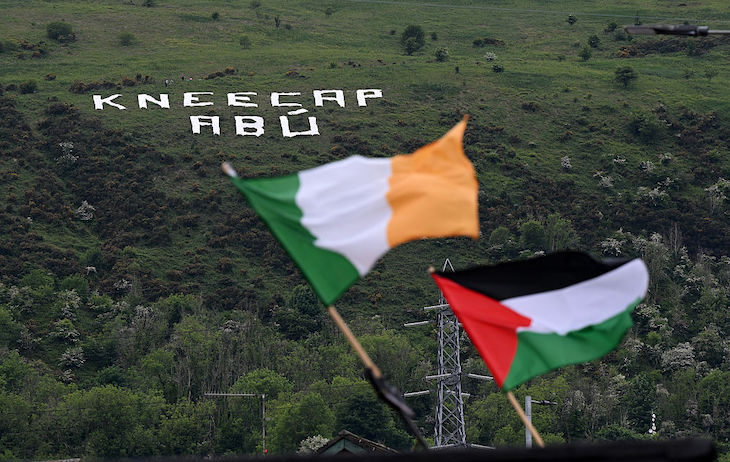In 1855, Paul Gauguin’s widowed mother Aline returned to her husband’s family in Orleans after seven years in Peru. She brought back her daughter Marie, eight-year-old son Paul and her collection of pre-Columbian artefacts. They had no commercial value but those strange objects, sprouting the heads of birds and animals, had a power that the westernised world had lost touch with. They sank deep into the imagination of her wild, headstrong boy, who often described himself as ‘a savage from Peru’.
After the sensory overload of South America, France and school were grey, cold and miserable. With education over, Gauguin insisted on going to sea and served in the navy in the Franco-Prussian war. He yearned for adventure, but his mother’s wealthy protector, Gustave Arosa, found him a job as a futures broker.
Van Gogh talked all the time and dragged Gauguin along for all-night blinders of sex and booze
Gauguin loathed industrialisation and always favoured handmade over mass-produced; but he proved very good at making money. He married in 1873 and took up painting and sculpture with passionate absorption, spending more and more time in his studio. While his Danish wife Mette looked after their growing family, he made friends with the Impressionists, invited them home to dinner (Mette enjoyed entertaining) and bought several of their paintings.
Then came the stock market crash of 1882, and years of misery followed. Gauguin couldn’t find a job or sell his paintings, and Mette took the children to live with her family in Copenhagen. With nothing to lose, he set out for the most remote and primitive part of France: Brittany. In Pont-Aven, to which he returned several times, he worked like a madman. Loading his paintings with colour and imagery, he fused the magical and the familiar, attempting to ‘show an inward and an outward state simultaneously’. In 1877 he started making ceramics. I confess that hitherto I have ignored these dark and faintly menacing objects, but Sue Prideaux describes them so vividly in Wild Thing that I shall look closer at the
images of strange beings that had been brewing inside him… globular, asymmetrical imaginings awkwardly anthropomorphised, interrupted by faces, limbs and orifices.
Over the next ten years Gauguin struggled on, his moments of hope regularly dashed, his money worries constant; but he was making a name for himself among the modernists. Vincent van Gogh idolised him, and begged him to come to Arles, where he would be master of an artists’ colony – the Studio in the South. Van Gogh bought 12 rush-bottomed chairs for Gauguin’s (non-existent) ‘disciples’ and painted three canvases – the ‘Sunflowers’ – to adorn his guest’s tiny room.
Gauguin’s stay in Arles, from October to December 1888, must have been a nightmare. Although the two men were painting during the day (Prideaux is good on how they inspired and challenged each other), van Gogh was obviously very disturbed. He talked all the time and dragged Gauguin along for all-night blinders of sex and booze in the village. The final straw came when van Gogh suddenly threw a glass of absinthe at his friend. Gauguin ducked and left the bar – only to find van Gogh coming after him with a cut-throat razor. Gauguin did not go home until the following morning, to be met by the chief of police – who immediately accused him of murder. Only when they went upstairs, following a trail of blood, did they find van Gogh fast asleep, having hacked off his ear. Much of Prideaux’s riveting chapter about this is based on Gauguin’s 200-page memoir Avant et Après. The manuscript was lost soon after the painter’s death, and only came to light three years ago.
Among those who thought about where art would go after Impressionism, Gauguin was recognised as the leader of the Synthesist-Symbolists. He maintained that art should be free of labels; but the more he worked, the more he wanted to touch the authentic, uncorrupted source that all art seemed to spring from. It had shrivelled in the hothouse commercialism of Europe. Might it be more evident in a world still untouched by western ‘civilisation’? In 1891 he raised enough money to buy paints, 100 metres of canvas and a passage to Tahiti.
The island had been a French colony for only 11 years, but ‘civilisation’ was already rampant. The capital, Papeete, was no longer a cluster of wood and bamboo dwellings, but rows of jerry-built brick shacks with a church at either end. The missionaries had destroyed most local traditions and insisted that Polynesian women dress in shapeless Mother Hubbard smocks. Gauguin moved away from Papeete and his compatriots as soon as he could and settled in a hut in a village by the sea. He had read that fishing was easy and fruit fell off the trees, but neither was true. He was often ill and always malnourished.
It was not until he found his wife, Tehamana, that Gauguin was able to realise his vision of Tahiti – a timeless landscape, peopled with men and women, saints and demons, animals and birds, in a dazzling synthesis of pre-Columbian, Christian and Polynesian imagery. He adored Tehamana, whose calm serenity he cherished as dearly as her beauty. But was he exploiting a teenage girl? In this century, Gauguin is regularly described as a child-molesting colonialist by those more eager to display their righteousness than understand the times in which he lived.
In 1894, Gauguin was savagely beaten up in Concarneau, where arty types were not welcome
This is dangerous ground, but the arguments Prideaux makes to defend Gauguin are backed by fact. Tehamana was about 13 when they started living together. To us this sounds horribly young for sexual initiation, but it was normal in her culture, as well as being the legal age of consent in France at the time. Her family also decreed that if she was not happy with her husband, she could come home in eight days. Of her own will, she stayed. Tehamana took another husband when Gauguin left for France for three years. When she heard he was back, she came and spent a few days with him, for old times’ sake.
When Gauguin returned to France with his paintings of Tahiti in 1892, his fame in Europe was spreading – thanks to a successful exhibition in Copenhagen of paintings by himself and van Gogh, who had died two years earlier. He revisited Pont-Aven in the spring of 1894 and was working well when disaster struck. He was savagely beaten up in the village of Concarneau, where long-haired arty types were not welcome. Gauguin was left with a leg and ankle fractured by kicks from men in wooden clogs, the shinbone sticking out through the skin. The bone was badly set, and the wounds to the shin were very slow to heal. He was on morphine for months and walked with a stick from then on.
He went back to Polynesia in 1895, never to return to France. He spent his final years in constant pain from his leg on the island of Hiva Oa, where he carved and painted and wrote indignant letters to French administrators about the injustices heaped on his neighbours. Some were forced to work for the local gendarme, and after a particularly destructive flood, men were expected to mend government roads before rebuilding their own houses. Yet Gauguin’s strenuous efforts to make their lives more bearable are often eclipsed by accusations that he came to Polynesia with syphilis and spread it all over the islands. However, analysis of four of his teeth in 2018 reveal that they were free of cadmium, mercury and arsenic – the most common treatments for syphilis at the time.
This evidence, plus the re-emergence of Avant et Après, which provides new insights into his relationships, fears and beliefs, as well as his childhood in Peru and the weeks with van Gogh, would have added considerable interest to any new biography. This one also benefits from Prideaux’s deep knowledge of 19th-century art and thought, gathered in writing her biographies of Edvard Munch, August Strindberg and Friedrich Nietzsche. The result, packed with beautifully reproduced illustrations, is a brilliantly readable and compassionate study of Gauguin – not just as a painter, sculptor, carver and potter, but as a human soul perpetually searching for what is always just out of reach.








Comments